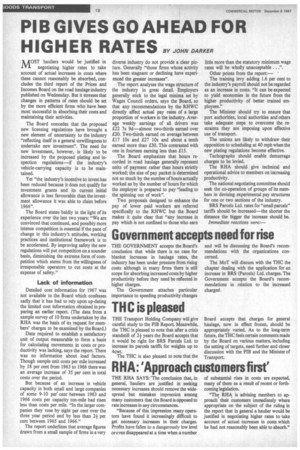P1B GIVES GO AHEAD FOR
Page 20

If you've noticed an error in this article please click here to report it so we can fix it.
HIGH ER RATES BY DARKER MOST hauliers would be justified in negotiating higher rates to take account of actual increases in costs where these cannot reasonably be absorbed, concludes the third report of the Prices and Incomes Board on the road haulage industry published on Wednesday. But it stresses that changes in patterns of rates should be set by the more efficient firms who have been most successful in absorbing their costs and maintaining their activities.
The Board concedes that the proposed new licensing regulations have brought a new element of uncertainty to the industry "reflecting itself in a general unwillingness to undertake new investment". The need for new investment, however, is likely to be increased by the proposed plating and inspection regulations—if the industry's vehicle-carrying capacity is to be maintained.
Yet "the industry's incentive to invest has been reduced because it does not qualify for investment grants and its current initial allowance is less favourable than the investment allowance it was able to claim before 1966".
The Board states baldly in the light of its experience over the last two years: "We are convinced that continued, and possibly more intense competition is essential if the pace of change in this industry's attitudes, working practices and institutional framework is to be accelerated. By improving safety the new regulations will put competition on a sounder basis, diminishing the extreme form of competition which stems from the willingness of irresponsible operators to cut costs at the expense of safety."
Lack of information Detailed cost information for 1967 was not available to the Board which confesses sadly that it has had to rely upon up-dating the limited cost information obtained in preparing an earlier report. (The data from a sample survey of 10 firms undertaken by the RHA was the basis of its request for members' charges to be examined by the Board.) Data required to establish a satisfactory unit of output measurable to form a basis for calculating movements in costs or productivity was lacking, says the report. There was no information about load factors. Though sample unit costs per mile increased by 18. per cent from 1963 to 1966 there was an average increase of 35 per cent in total costs over the period.
But because of an increase in vehicle capacity in both small and large companies of some 9-10 per' cent between 1963 and 1966 costs per capacity ton-mile had risen less than costs per mile. "In the larger companies they rose by eight per cent over the three year period and by less than 21 per cent between 1965 and 1966."
The report underlines that average figures drawn from a small sample of firms in a very diverse industry do not provide a clear picture. Generally "those firms whose activity has been stagnant or declining have experienced the greater increases".
The report analyses the wage structure of the industry in great detail. Employers generally stick to the legal minima set by Wages Council orders, says the Board, so that any recommendations by the RHWC directly affect actual pay rates of a large proportion of workers in the industry. Average weekly earnings of all drivers was £22 7s 9d—almost two-thirds earned over £20. Two-thirds earned on average between £17 lOs and £27 10s and about a tenth earned more than £30. This contrasted with one in fourteen earning less than £15.
The Board emphasizes that hours recorded in road haulage generally represent units of payment rather than hours strictly worked; the size of pay packet is determined not so much by the number of hours actually worked as by the number of hours for which the employer is prepared to pay "leading to the spinning out of work".
Two proposals designed to enhance the pay of lower paid workers are referred specifically to the RHWC but the Board makes it quite clear that "any increase in pay which is not confined to those who earn little more than the statutory minimum wage rates will be wholly unacceptable. .". Other points from the report:— ' The training levy adding 1.6 per cent to the industry's payroll should not be regarded as an increase in costs. "It can be expected to yield economies in the future from the higher productivity of better trained employees."
The Minister should try to ensure that port authorities, local authorities and others take adequate steps to overcome the restraints they are imposing upon effective use of transport.
The unions are likely to withdraw their opposition to scheduling at 40 mph when the new plating regulations become effective.
Tachographs should enable demurrage charges to be levied.
The RHA should give technical and operational advice to members on increasing productivity.
The national negotiating committee should seek the co-operation of groups of its members in devising experimental pay structures for one or two sections of the industry.
BRS Parcels Ltd. rates for "small parcels" tariffs should be increased—the shorter the distance the bigger the increase should be.
Immediate reactions were:—








































































































